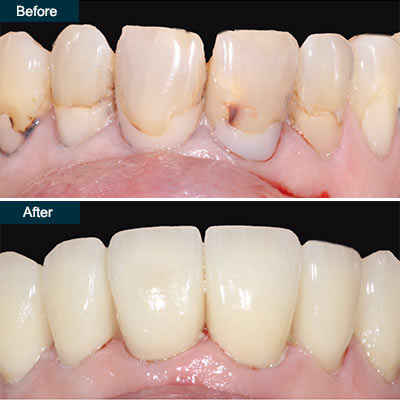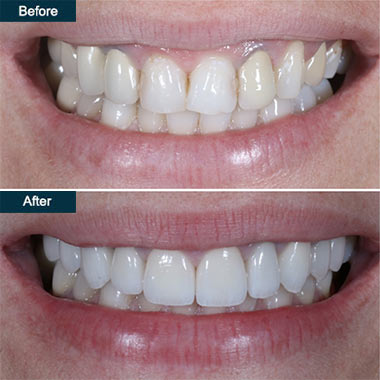Table of contents
Dental veneers are made from very thin, durable porcelain, designed so that they fit precisely over the front surfaces of teeth.
They are a versatile option for anyone with less than aesthetically pleasing teeth.

Consider porcelain veneers to cover teeth that are:
Porcelain veneers can correct the appearance of teeth that are too small or not quite the right shape.
If you have some teeth that are slightly out of alignment, porcelain veneers can be a faster alternative to orthodontic treatment, and especially if the misaligned teeth will benefit from being covered.
Do you have large, unsightly spaces between your teeth? Porcelain veneers could close or at least reduce these gaps if they are especially large, and are another alternative to orthodontic treatment.
Lots of people have teeth whitening treatments, but while effective, the procedure won’t always work on all tooth stains.
Some tooth stains are too deep or are internal and cannot be removed with a teeth bleaching treatment.
Porcelain veneers can hide teeth that are severely stained. They can also mask the natural color of teeth that appear too dark.
Some people opt for multiple veneers that cover most or all of the teeth showing when they smile or talk and can choose new porcelain veneers that are a shade or two lighter.
Initially, you will need to see a good cosmetic dentist for a consultation. They can assess the condition of your teeth and your overall dental health. For a successful treatment, you need to have teeth that are relatively strong and healthy.
They shouldn’t have any large fillings or larger areas of decay. You shouldn’t have any signs of dental diseases. If you do have active dental disease, you will need dental treatment to restore oral health before you have your porcelain veneers.
When veneers are fitted onto healthy teeth, they are more likely to last longer, allowing you to gain maximum benefit from this procedure.
The next stage is to prepare your teeth for the veneers, which is done using local anesthesia.
Although very thin, porcelain veneers are still around 0.5mm thick. A similar amount of material must be removed from the tooth surfaces to ensure the veneers don’t feel and look too big and bulky.
Once the teeth are prepared, your cosmetic dentist will take a dental impression that is sent to the dental lab, along with precise instructions on the shade and design of your new veneers. While your new veneers are made, your dentist fits temporary veneers to protect your prepared teeth and to prevent problems like tooth sensitivity.
Once your veneers are ready, you return to the dental office so the temporary veneers can be removed and your permanent veneers fitted.
The veneers are adjusted if necessary to ensure they fit precisely before they are bonded onto the teeth, completing your treatment.
Laminates or Lumineers are similar to porcelain veneers but are made from a special type of porcelain that is stronger, and most importantly, it’s a lot thinner.
Instead of a typical thickness of 0.5 mm, Lumineers are just 0.2 mm in thickness. This means that instead of your dentist preparing your teeth by removing a small amount of tooth enamel, it may be unnecessary to have any preparation whatsoever. Instead, your tooth structure will remain fully intact.
It is a critical distinction because when your dentist removes any tooth structure, it means that the process is irreversible. While porcelain veneers will last ten years or more, they will need replacing eventually.
In contrast, Lumineers often require no tooth preparation, and they are made from a stronger and more durable type of porcelain that can last 20 years. While Lumineers may initially cost a little more, they could be a better investment in the longer term.

Lumineers can hide the same imperfections in your teeth as conventional porcelain veneers. However, unlike conventional veneers, you most likely will not need any temporary veneers while your Lumineers are being fabricated.
Instead, your dentist will take a detailed dental impression and make a note of the shade and design of your Lumineers, and that is it. You will return a couple of weeks later so your new Lumineers can be fitted.
However, it is important to know that Lumineers are best suited for specific situations. If you wish to correct the positions of teeth that are out of alignment and which are slightly protrusive, your dentist will still need to reshape these teeth before fitting Lumineers as otherwise, they cannot bring them back into line.
Often, Lumineers and porcelain veneers are used as part of a larger and more comprehensive smile makeover. These treatments work well with other procedures, including crowns and bridges, dental implants, and adult orthodontics.
Your cosmetic dentist will always suggest a combination of treatments they feel will best achieve the results you desire while being minimally invasive.
Using more than one treatment doesn’t necessarily increase the cost of a smile makeover. It can often be more cost-effective than opting for a one-size-fits-all treatment approach that could remove tooth structure unnecessarily.
For example, you may have one or two teeth that could benefit from covering entirely with dental crowns, but fitting a crown requires substantial reshaping where a grinds away a significant part of the tooth, creating enough room for a crown.
Using dental crowns and veneers ensures those teeth that don’t need crowns will receive less invasive treatment.
If you do want a more comprehensive smile makeover, your cosmetic dentist should explain each recommended treatment carefully, so you understand why they have selected a specific procedure and how exactly it will help you.
For more information about veneers or lumineers call or visit our dentistry center in Brooklyn, NY.